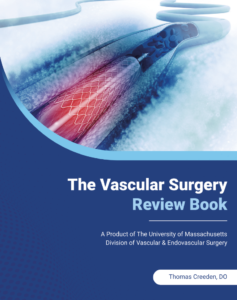 When University of Massachusetts Medical School integrated vascular surgery resident Thomas Creeden, DO, was preparing for his first Vascular Surgery In-Training Exam (VSITE), it struck him there was a gap in the market. While those training in most other surgical specialties had access to a high-yield textbook with which to prepare for exams, boards and even rotations, he mused, vascular surgery did not. “The modern-day textbook is something like 4,000-pages long, and seems kind of daunting,” Creeden told Vascular Specialist@VAM.
When University of Massachusetts Medical School integrated vascular surgery resident Thomas Creeden, DO, was preparing for his first Vascular Surgery In-Training Exam (VSITE), it struck him there was a gap in the market. While those training in most other surgical specialties had access to a high-yield textbook with which to prepare for exams, boards and even rotations, he mused, vascular surgery did not. “The modern-day textbook is something like 4,000-pages long, and seems kind of daunting,” Creeden told Vascular Specialist@VAM.
So he decided to do something about the anomaly: After some encouragement from mentors, he went ahead and produced one himself. The result is The Vascular Surgery Review Book.
What started out as a culling-together of his notes in intern year morphed into a more organized undertaking during the second and third. Eventually, he got serious with the encouragement of UMass vascular chief Andres Schanzer, MD, and program director Jessica Simons, MD.
The driving force was to create a reference text that would be fundamentally easier and quicker to work through.
The book was published in the middle of June, and is available both in print and as a Kindle edition. It was also available at the University of Massachusetts table at the General Surgery Resident/Medical Student Program: Residency Fair during the Vascular Annual Meeting (VAM) in Boston (June 15–18).
Creeden, who was in attendance at the table, was himself drawn to vascular surgery after a process of elimination, realizing he enjoyed the blend of minimally invasive procedures, open surgery, medicine and critical care.
“Once I spent a month on it, I wanted to spend another month on it, and then another month, and it just started snowballing for me,” he said.
The book publishing process ramped things up a notch. Creeden spent much of his spare time putting the title together, but then realized over the last three or four months the easy part was writing it.
Once he had navigated potential copyright pitfalls, he hired professional help to complete the publishing process, including a medical illustrator and a cover designer. “I’ve been very encouraged hearing other vascular surgery training programs are already utilizing the book and providing copies for their residents,” he added












